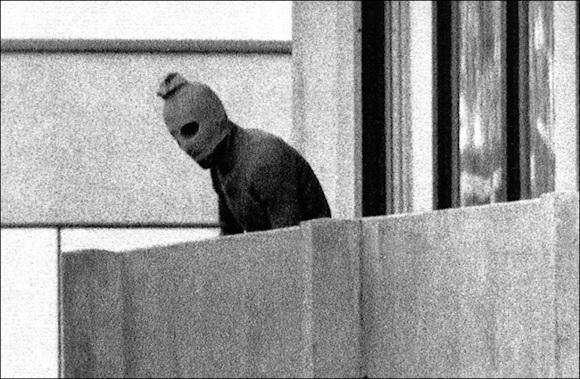In 1970, King Hussein of Jordan came to an inevitable rupture with the Palestinians whose presence within the Kingdom had become uncomfortable and cumbersome. The Palestine Liberation Organization, led by Yasser Arafat, had effectively overstepped the boundaries turning Jordanian territory into a logistic base for various guerilla organizations. Moreover, the secret services of Amman became aware of a plan hatched by the Palestinians themselves to kill the monarch. The news of a possible attack infuriated Hussein who immediately elected a military government directed by Brigadier General Muhammad Daud, ordering the violent repression of every nucleus of the fedayn operating in Jordan. The organization of Arafat renamed that sad period of civil war in "Nero Nero", a name that soon became synonymous with terror and violence. In the fall of 1971 Salah Khalaf and Sabri al-Banna, or better known as Abu Nidal, they formed an autonomous group from al Fatah, whose main objective was to hit both Israelis and Jordanian traitors as hard as possible.
Operation Iqrit and Biri'm '
In November 1971 some members of "Black September" took revenge on the treatment of King Hussein by assassinating Jordanian Prime Minister Wasfi Tal during his visit to Egypt. The following year the same organization was the author of one of the most dramatic episodes in the history of civil aviation: the 8 and 9 in May the terrorists hijacked the Sabena 571 flight with 101 people on board. On that occasion the tragedy was averted by the intervention of the Israeli special forces of the Sayeret Matkal who showed the world their lethal efficiency.
The Abu Nidal militia, far from being defeated, longed to return the blow to Israel and the opportunity presented itself at the Munich Olympics, scheduled for the 26 in August at the 11 1972 in September. The Olympics have always been an important event not only from a sporting point of view, but also from a political point of view. The 20th edition of Monaco, for example, expressed the redemption of a Germany in full recovery, but still with the morale shaken by the tragic events of Nazism. Bringing together all the nations of the world in the name of sport meant a great deal to the Germans; nevertheless, on the Bonn government there were heavy responsibilities concerning the protection of his guests, in a period where Marxist terrorism was particularly active. Among the participating nations there was also Israel, whose delegation had arrived on German soil although the security guarantees were not comforting.

Samuel Lalkin, head of the Israeli representation, was not at all quiet. A few days before the opening ceremony, the former IDF major arrived in Monaco to assess with his own eyes the surveillance measures set up in places that would have welcomed the athletes1. The building at Connolly Strasse's 31 number - chosen to house the Tel Aviv team - was accessible to everyone - there was no bolt and no one was able to enter the athletes' rooms with relative ease. If it were up to Lalkin's judgment, the Israelis would have to refuse to stay in the stable one. However, the prestige of a young nation was at stake and a veto - however plausible - would have been blamed by the whole world. The Israeli team, contiguous to that of Hong Kong and Honduras, was therefore aware of its vulnerability: the same sportsmen had found that on the Connolly Strasse there was a continuous coming and going of unauthorized persons. Of these shortcomings, the eight Palestinians of September Black which - thanks to the complicity of some militants of the Baader-Meinhof - had arrived in Monaco without arousing any suspicion. The operation started Iqrit and Biri'm ' from the name of two Palestinian villages hit by the Israeli army. The attack plan hatched by September Black it was very simple and involved kidnapping Israeli athletes and then exchanging them with over two hundred prisoners held in Tel Aviv prisons.
At dawn on September 5, the terrorists, disguised as sportsmen, approached the door that led into the rooms of the Israeli team. To secure the surprise factor, the Arabs had obtained duplicate entry keys, but as soon as they put them in the lock something went wrong. The attempt to force the door woke the occupants: the terrorists, now discovered, broke down the entrance screaming at the Israelis not to move. Some of them tried to fight back but the Palestinians responded by opening fire with AK47s and instantly killing Moshe Weinberg, the wrestling team coach, along with another friend of his. The survivors were beaten up and dragged to another room: the head of September Black he knew that from that moment on, time would have been their precious ally. The noise and the screams of the people immediately activated the Munich police who sent 300 agents to the site, who surrounded the building. After the first hectic hours, a Palestinian spokesman sent the police a letter containing the names of 236 detainees to be released in exchange for the lives of the few Israelis. Also on the list was the name of Kozo Kamoto, a Japanese terrorist accomplice in the Sabena flight hijack, as well as Ulrike Meinhof and Andreas Baader, the leaders of the homonymous group in West Germany.2.
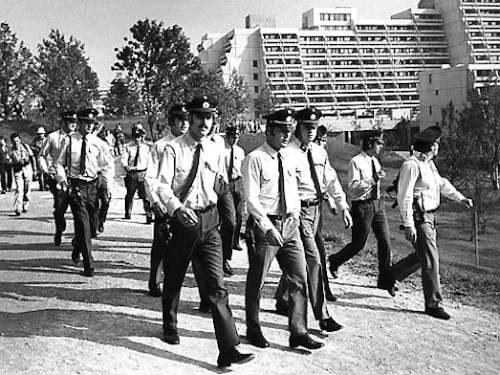
The negotiations
The first policeman to talk to the Arabs was Manfred Schreiber in the dual role of head of security for the Olympic village and the Munich police. Schreiber was aware of playing a secondary role and could not take responsibility for direct negotiations with terrorists3. The policeman also knew that the Palestinian demands could not be accepted by his government, but only by Israel. The claim to release for Ulrike Meinhof and Andreas Baader, however, put the government of Willi Brandt in an unenviable situation because the most difficult knot to untangle was to relate to Golda Meir, determined not to give anything to the terrorists.
Meanwhile the leader of September Black, Mohammed Mahmud Essafadi (name of battle Issa, Jesus in Arabic) granted the police a time limit to free the detainees; if this had not been possible, he would have started killing hostages. Thanks to the intercession of Schreiber, Issa granted an extension of three hours, however, demanding that the federal police authorize the transfer of the Israelis from the Connelly Strasse to the airport of Monaco. Once in Fürstenfeldbruck the terrorists wanted three planes ready to take off at staggered times to an unknown location.
The intransigence of Israel and the blatant inability of the German authorities to deal with the kidnappers did not promise anything good and the police seriously began to consider a force intervention to free the hostages. The audacious action of September Black meanwhile, he was enjoying an extraordinary echo throughout the world: their enterprise was already in itself an important victory because it had brought the Palestinian question to the fore. Essafadi, a good interpreter of the media stage, gave the authorities another two hours' time, reducing the request to just one aircraft ready to take off for Egypt, while the number of Palestinians to be released denied further decreases4. Everyone hoped until the end that Israel granted something, but it was evident - Schreiber thought - that no one among Arabs and Israeli athletes would ever leave Germany.
The attack

By now the negotiations came to a standstill the police commander considered the only option left: free the hostages with a forced action. Until then, the Germans had proved to be bad intermediaries and some solutions proposed to eliminate terrorists were almost ridiculous. Aaron Klein cites some grotesque intervention plans with policemen disguised as cooks, poisoned food and even unarmed agents, but martial arts experts, infiltrated through the air conditioning ducts. All the policemen knew how to act in a simple urban patrol context, but no one had ever shot in critical conditions with the presence of civilians5. In addition to this, not even one of the authorities thought to send a professional "negotiator" capable of understanding the psychological situation of the terrorists who - important but neglected - always acted covered, showing that they had no intention of dying or sacrificing themselves for the cause.
There were only four ways to pass from Schreiber: the first to attack the terrorists where they were, penetrating inside the Connelly Strasse apartment, the second was to catch them by surprise during the transfer to the helicopters that would take them to the airport, the third attack them while they were climbing on the helicopters or, fourth and last solution, attempt an ambush while boarding the planes. The first option was immediately excluded, and only the second and fourth were considered more reasonable, but always with a high degree of risk. Scheriber and his helper Georg Wolf were groping in the dark: the number of terrorists was still uncertain and no one really knew what the conditions of the prisoners were.
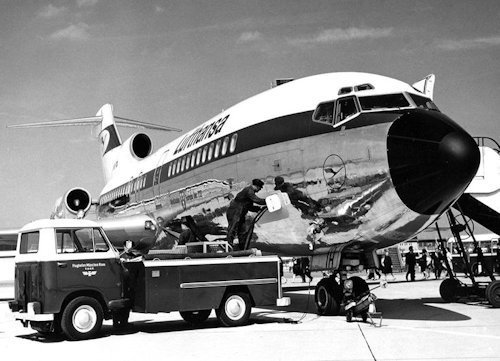
At the Fürstenfeldbruck airport two police squads were awaiting the arrival of the convoy: the first team was ready to neutralize Issa and her deputy who, according to the conjectures of Schreiber, would come up first to inspect the plane; the second one, composed of five selected shooters, would have acted outside keeping the rest of the group at bay. A first worrying sign of how things would have happened when the team of agents in charge of eliminating the leaders of the Palestinian commando decided to leave, motu proprio, the mission not to risk your life for nothing. The officer boarded the plane, Reinhold Reich, criticized with his men the orders received: all agreed on the unnecessary risks that would have run if they had remained in stock of 727 and without any orders left the plane sheltering behind a compound near the tower control. The retreat of the German officer and his team was certainly a gesture of unacceptable cowardice, although the fears revealed by Reich had something well founded. Schreiber and Wolf had, in fact, ordered that the aircraft be refueled at full fuel: what would happen - Reich thought - if a bomb or a stray bullet had hit the tanks?
Mohammed and his aide first reached the Lufthansa aircraft while the rest of the group with the hostages waited near the helicopters; no official from the observation post was able to understand what was happening on the runway. The selected shooters stationed had become insufficient, since the terrorists to be kept under fire were no longer five, but eight. In addition, no sniper had coordinated with the helicopter pilots to land in order to offer them an optimal angle of fire. Finally, given even more serious and stunning, i Sniper they did not even have a radio to communicate with each other6. As Issa and the other terrorist walked towards the plane, the German commander ordered the shooters to fire two of the terrorists who guarded the hostages, but only one bullet reached the target. The first two shots followed those of the other shooters, one of whom wounded the second of Issa. At that point, fires of AK 47 followed and a shootout between terrorists and police began: the gun battle with the Israelis still in the hands of September Black it was the nefarious event that no one would have expected. All the Israelis were killed, and five terrorists and an agent fell.
The consequences
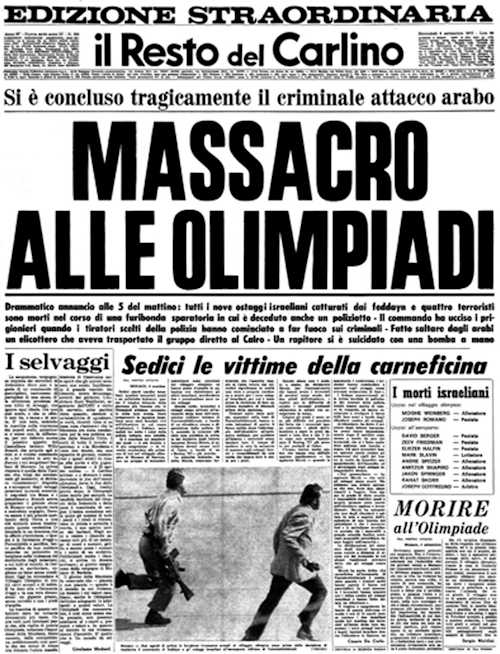 The deaths of Israeli athletes and the mistakes made by the Germans in Monaco spurred several European countries to wonder about the best ways to deal with the growing threat of terrorism. What had not worked in Monaco? What were the powers and margins of Schreiber's negotiation and how much politics had influenced his decisions? Could the police, with the tools at their disposal, fight against certain terrorists?
The deaths of Israeli athletes and the mistakes made by the Germans in Monaco spurred several European countries to wonder about the best ways to deal with the growing threat of terrorism. What had not worked in Monaco? What were the powers and margins of Schreiber's negotiation and how much politics had influenced his decisions? Could the police, with the tools at their disposal, fight against certain terrorists?
The federal police had undoubtedly acted in a clumsy way, nevertheless he had done everything possible within the limits in which it was usual to operate normally. The agents of Monaco did not have the necessary skills to calculate all the variables of a case like that and to prove it was the guilty and burdensome lack of intelligence throughout the operation. The team of agents detachment to surprise Issa inside the Boeing 727 and then escaped to "avoid unnecessary risks", revealed a total lack of "cold blood". The same applies to the selected shooters who decided to press the trigger without any signal from their colleagues at the border.
The only certain fact that emerged from the Munich disaster was that if the same episode had happened in any other European capital, the police reaction would have been identical, or almost. What happened in Germany therefore favored the establishment of police units especially dedicated to the management and resolution of high-risk situations. But who could instruct agents to act in situations where in addition to neutralizing the enemy you also had to save lives?
In the early 1970s, the only ones who developed effective counter-terrorism measures were England and Israel. The other countries still thought to face urban guerrilla contexts by implementing the presence of law enforcement or by improving some basic equipment. The Munich massacre proved that all this was not enough. In fact, it was necessary to intervene on the mindset law enforcement agencies that regulated the conduction of seizures, hijackings or violent events involving the unarmed.
In the 1972, London had just embarked on the bloody fight against IRA militants, creating the first undercover units, the Mobile Reconnaissance Force. In the early sixties the 22 ° Special Air Service he formed the Counter Revolutionary Warfare Wing (CRW) which originally had as its main purpose the protection of VIP whose functions were to protect the interests of Britain in every part of the world7.
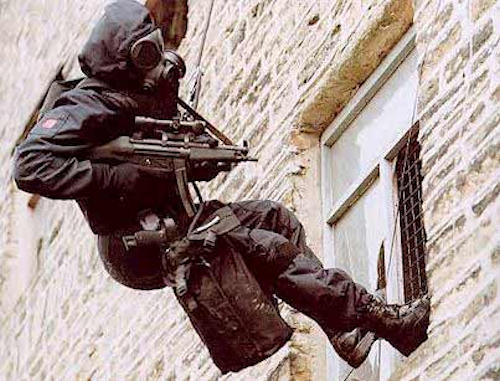
Just the episode of the Olympics changed the type of training of the CRW turning it into one of the most fearsome and efficient in the world8. Moreover, SAS itself became the reference point for the creation of similar units in Europe and even in the United States where Colonel "Charlie" Beckwith - back from an informative stay in Hereford - laid the foundations for the establishment of the Delta Force. France and Germany followed the British example with the creation of the GIGN (Groupe d'Intervention de la Gendarmerie Nationale) and the GSG9 (Grenzschutzgruppe 9); a few years later Italy also authorized the formation of the GIS (Special Intervention Group) of the Carabinieri and the NOCS (Central Security Operating Unit) of the Police.
The GSG9
The incompetence of the West German police acted as scapegoats to explain the Munich massacre. As noted above, the poor preparation of agents heavily influenced the outcome of the entire operation. As the storm winds subsided, the then German interior minister, Hans Dietrich Gencher, ordered the establishment of a special unit capable of competing on equal terms with the terrorists. The 26 September 1972 the Bonn government therefore established that within the Federal Border Police, the unit then known as GSG9 was trained. The decree of foundation did not follow a subsequent one, the 15 February 1974, which sanctioned the operational responsibilities: "particular special police missions will be assigned to the GSG9. They will be engaged in those cases where circumstances impose a single response action against violent criminals. This especially in cases where terrorist organizations hit "9. In other cases the GSG9 could intervene in support of the federal police when it was not able to coordinate high-risk situations10.
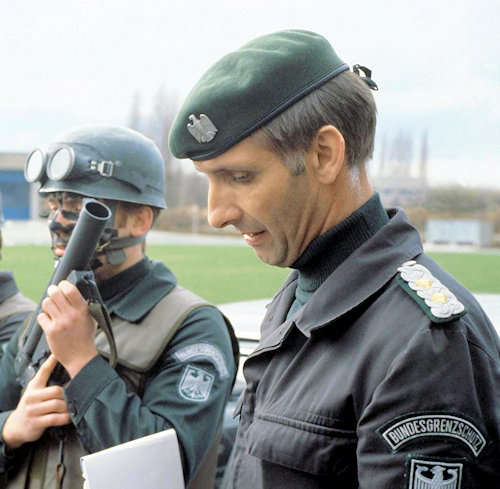 Under the command of the unit was Colonel Ulrich Wegener (photo) who was tasked with structuring a type of training that combined the techniques of counter-guerrilla warfare with the normal police. The German commander - who had also spent four weeks training with Israeli paratroopers - succeeded in combining the two procedures because, as was dictated by the government itself, the terrorists were to be treated according to a military methodology.
Under the command of the unit was Colonel Ulrich Wegener (photo) who was tasked with structuring a type of training that combined the techniques of counter-guerrilla warfare with the normal police. The German commander - who had also spent four weeks training with Israeli paratroopers - succeeded in combining the two procedures because, as was dictated by the government itself, the terrorists were to be treated according to a military methodology.
In the 1974 the GSG9 counted about 200 men with a headquarters, three combat units, information gathering and communications units, genius specialists, a training section, helicopters and logistics11. Although the Teutonic formation was inspired by the SAS and Israeli special departments, the main foundations for conducting urban guerrilla warfare came from the theories of Brazilian policeman, Carlos Maringhella, author of the Mini Manual do Guerrilherio Urbano in which he argued that to get the most out of a fight in the city it was necessary to employ small action units consisting of no more than four or five people. The relevant thing, on which Wegener insisted, was the interchangeability of his men: everyone had to be ready on the same level and with the same knowledge. For this reason the selection of recruits was very strict and took place exclusively among the best elements of the border police (all had to have at least two and a half years of service). Over time the German team developed its own peculiarities, including the use of particular weapons: the GSG9, for example, was the first to use the Heckler & Koch MP5 machine guns, which shortly after became the weapon of choice of the units counter-terrorism.
Monaco's mattanza did not stop September Black who continued his criminal activity for several years; other attacks and further hijackings would have marked the history of many European cities which, however, began to respond with violent determination to terrorist blackmail.
1 Aaron J. Klein, Striking Back. The 1972 Munich Olympics Massacre and Israel's Deadly Response, New York 2005, p. 20.
2 Ibidem, p. 48.
3 F. Bolz-KJDudonis-DPSchulz, The Counterterrorism Handbook. Tactics, Procedures, and Techniques, Boca Raton-London-New York 2012, p. 100.
4 Ibidem, p. 101.
5 Striking Back, cit., pp. 63-64.
6 L. Thompson, The Counterterrorist Manual. A Practical Guide to Elite International Units, London 2009, p. 21.
7 P. Macdonald, The SAS in Action, London 1990, p. 76
8 The first Close Quarter Battle House, later called Killing House, was structured after the experience in Oman and the protection service to the Sultan Qaboo. In the rooms they began to train SAS security guards and teams prepared for possible hostage releases. On their return from Oman, former security officers in the sultanate began recruiting other colleagues for the formation of bodyguard teams. In the Seventies the men's escort service of the 22 ° declined and the same CRW Wing it was resized. The Munich tragedy convinced the British government to give more resources to the Regiment to perfect a type of counter-terrorism training. T. Geraghty, Who Dares Win. The Story of the 1950-1980 SAS, Tiptree Essex 1980, pp. 221-223.
9 R. Tophoven, GSG9. German Response to Terrorism, Bonn 1985, p. 11.
10 The management of special operations in a federal state was subordinated to the decentralized government, the same was true for units such as the GSG9 whose actions - dependent in the first instance on the Ministry of the Interior - always responded to local authorities, without overlapping the Lander police. Ibid.
11 Ibid, p. 18.
(photo: web)

